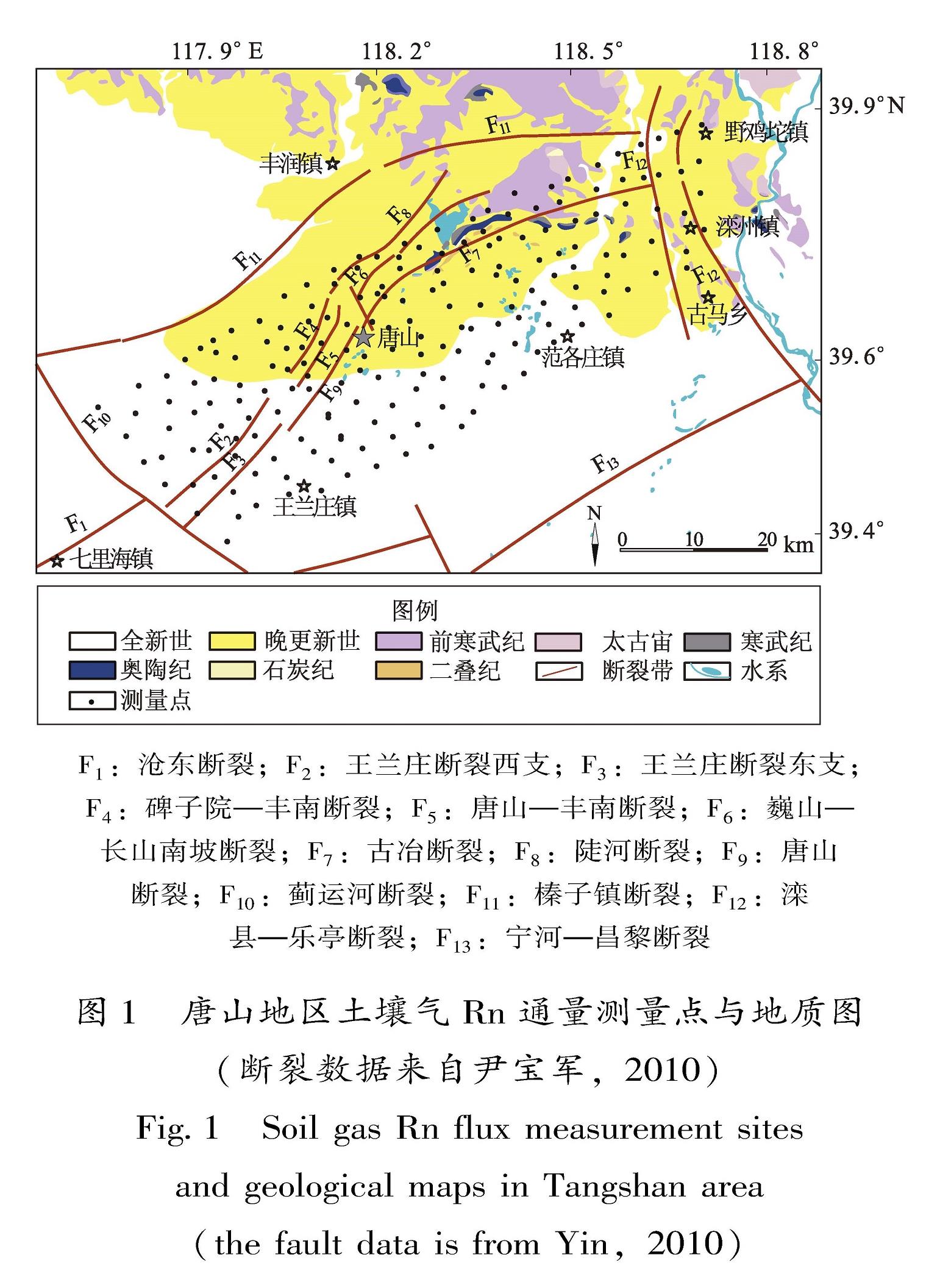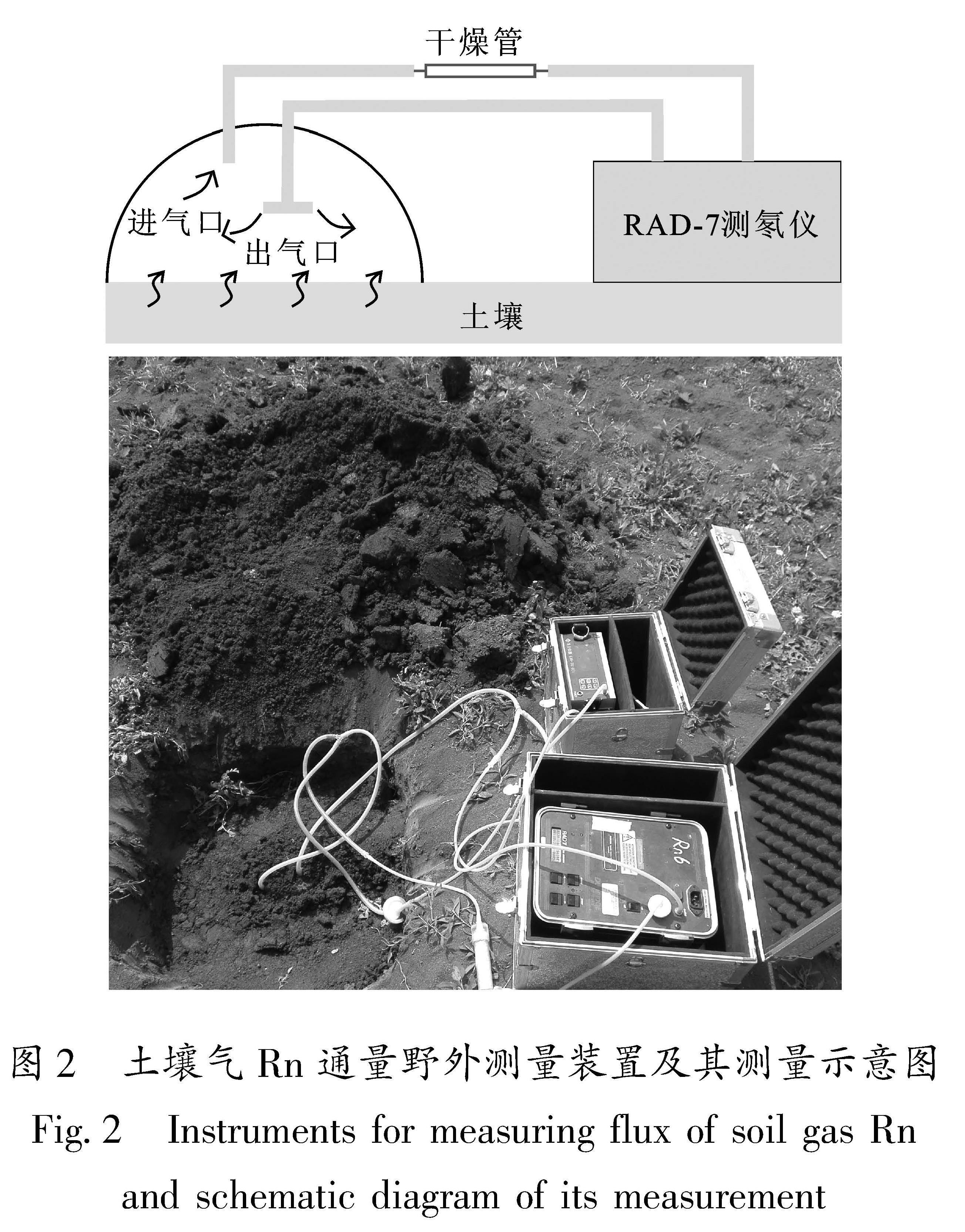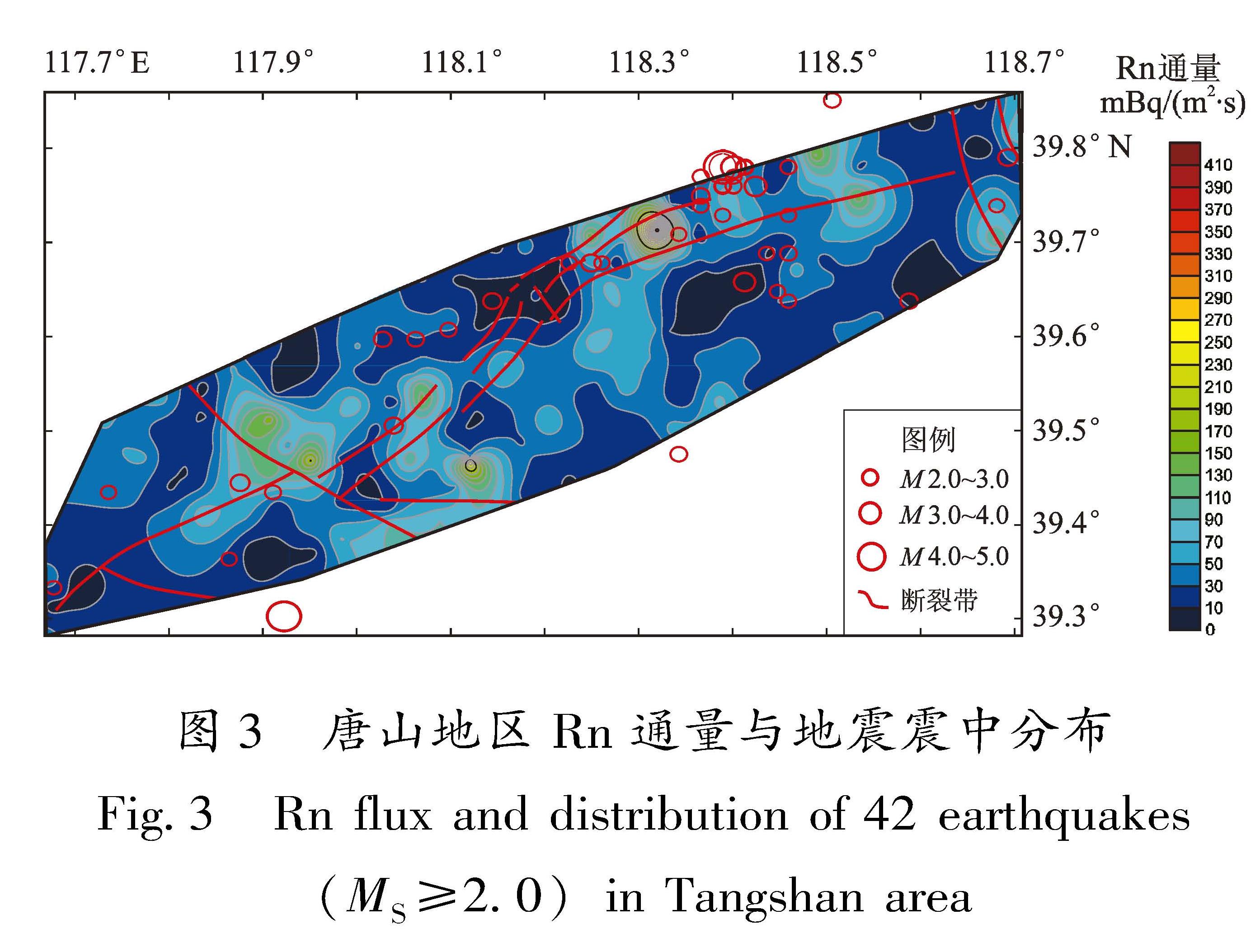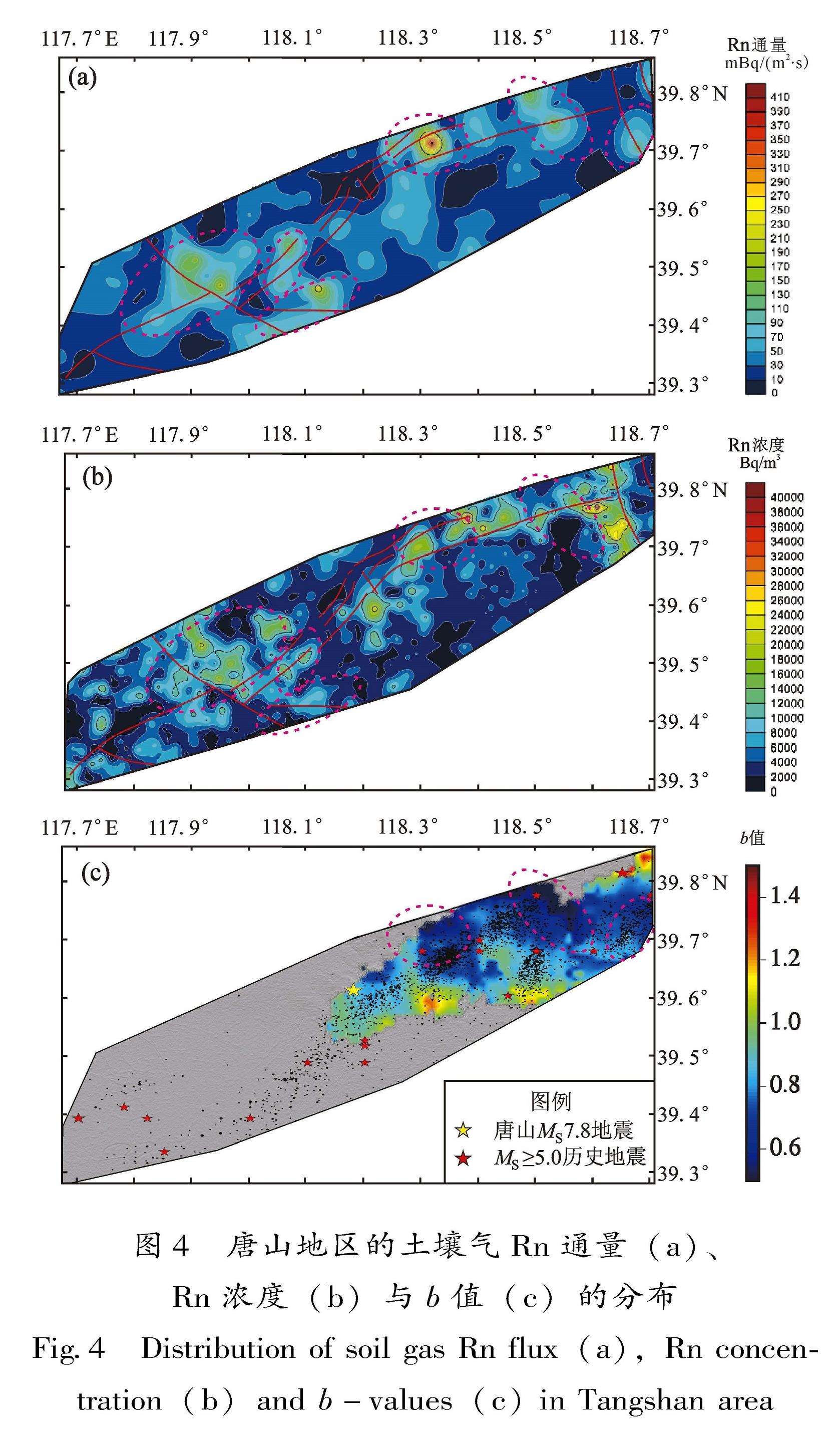基金项目:高压物理与地震科技联合实验室开放基金(2021IEF0101)和国家自然科学基金面上项目(42073063)联合资助.
(1.中国地震局地球物理研究所,北京 100081; 2.中国地震局地震预测研究所,北京 100036; 3.中国地质大学(北京)地球科学与资源学院,北京 100083)
(1.Institute of Geophysics,China Earthquake Administration,Beijing 100081,China)(2.Institute of Earthquake Forecasting,China Earthquake Administration,Beijing 100036,China)(3.School of Earth Science and Resources,China University of Geosciences(Beijing),Beijing 100083,China)
DOI: 10.20015/j.cnki.ISSN1000-0666.2022.0029
备注
基金项目:高压物理与地震科技联合实验室开放基金(2021IEF0101)和国家自然科学基金面上项目(42073063)联合资助.
引言
地震的孕育和发生是地下物质迁移、能量释放和应力改变的过程。在此过程中,断裂带及其周边区域流体的地球化学特征会发生改变(King et al,1996; 陶明信等,2005; 郭正府等,2017; Buttitta et al,2020)。土壤气作为一种可以客观、灵敏地反映地壳中应力、应变状态的流体,已被广泛应用于地震监测、活动断层识别、环境评价等领域(王诗东等,2011; Ichedef et al,2013; 周志华等,2014; 李静等,2018),其观测组分通常包括Rn、Hg、SO2、CH4等气体(Li et al,2013; Peiffer et al,2014; 刘兆飞,2020)。
Rn是铀和钍衰变过程中产生的一种惰性放射性气体,广泛存在于地壳中。Rn的释放受到环境中物理条件(地质条件、大气等)的影响,而不受化学过程的影响(Reddy et al,1996),且由于其在自然界中的低浓度和短半衰期(3.825 d),土壤气Rn作为气体来源的指示剂(Pinault,Baubron,1996),被广泛应用于监测构造与地震活动(苏鹤军等,2020; Muto et al,2021; Zhou et al,2020,2021)。
地球脱气是指地球演化过程中挥发性分类从内部向外部运移的过程。对于脱气研究多数集中在火山区(Chiodini et al,2008)、温泉区(Walter et al,2020)、裂谷区(Muirhead et al,2020)等,而对地震断裂带的排气研究相对较少(周晓成等,2017)。目前,唐山地区已开展大量与土壤气相关的研究工作,多聚焦于断裂带剖面的土壤气浓度与通量测量(韩晓坤,2014; 王喜龙等,2017; Chen et al,2018)、不同时间的多期次测量(杨江等,2019; 盛艳蕊等,2020)、土壤气浓度的异常判定以及影响因素等(Wang et al,2014; 赵元鑫,2021),也有对不同深度(0.2 m、1 m)土壤气通量的差异和成因的讨论(赵红坤等,2020)。
目前关于唐山地区土壤气浓度与通量之间的关系、通量浓度的控制因素等方面的研究还比较薄弱,缺乏对土壤气Rn通量的背景场的研究。2021年8月,中国地震局地震预测研究所流体地球化学团队对唐山地区的196个测点进行了土壤气Rn通量测量,旨在建立区域内土壤气Rn通量背景场,本文探讨其空间分布特征及影响因素,如地震活动、测量条件、b值。
1 地震地质背景
1976年,河北省唐山市发生震惊世界的MS7.8地震,唐山地区地震活动至今仍然活跃,是良好的地震科学研究试验场。近5年来,研究区(图1)发了42次MS≥2.0地震,其中包括2019年12月丰南MS4.5地震和2020年7月古冶MS5.1地震。
唐山地区位于燕山南缘,紧邻华北平原北部,被宁河—昌黎断裂、丰台—野鸡坨断裂、滦县—乐亭断裂和蓟运河断裂切割成NEE向的菱形块体。块体下方存在地幔隆起,隆起高度可达10 km(刘启元等,2007)。唐山断裂位于菱形块体NE向的对角线上,由陡河断裂、巍山—长山南坡断裂与古冶断裂3条平行的NE向断裂组成(虢顺民等,1977),相邻区域的构造单元也有一系列断裂发育(图1)。唐山断裂是一条右旋走滑的第四纪同生断裂,倾角高、倾向NW,错断了第四纪地层,且下盘沉积厚度大于上盘(郝书俭等,1998; 李建华等,1998)。深地震反射结果显示,唐山断裂浅部呈花状构造,深部切穿莫霍面,控制了该区地震的发生(刘保金等,2011)。区域第四纪沉积厚度为100~800 m,北薄南厚。在丰南以北,唐山断裂带以西,NNE向的第四纪小凹陷最大沉积厚度为400 m,断裂两侧的第四纪沉积落差可达200 m; 而在丰南以南、唐山断裂带以东,尖字沽第四纪凹陷的最大沉积厚度为800 m,断裂两侧的第四纪沉积落差也达200 m(江娃利,2006)。
唐山地区地层复杂,以第四纪地层出露为主,包括太古宙的潘庄变质二长花岗岩和汉儿庄片麻岩套柳河峪片麻岩; 前寒武纪(震旦纪)雾迷山组碳酸盐岩、青白口纪龙山组河流相沉积(砂岩、含砂砾岩及粉砂岩等)和长城纪高于庄组浅海相碳酸盐岩; 寒武纪昌平组(灰色、灰黑色厚层—块状豹斑状粉晶—微晶灰岩及灰质白云岩); 奥陶纪冶里组(灰色厚层、中厚层状灰岩夹少量砾屑灰岩及少量很薄的黄绿色页岩); 石炭纪本溪组(页岩、砂岩夹海相灰岩和不稳定的煤层); 二叠纪山西组(由陆相砂岩、页岩、煤构成的旋回层组成)(图1)。
2 采样分析及计算结果
在2010年756个土壤气Rn测量点位置基础上(Li et al,2013),中国地震局地震预测研究所流体地球化学团队于2021年8月在唐山断裂带及周缘,按照沿断裂、等间距、高密度的方法,根据野外实际情况选取了196个测点,使用静态暗箱法测量土壤气Rn通量,通量箱壁厚5 mm,聚四氟乙烯半球壳半径为20 cm(图2)。测量仪器为美国 Durridge 公司的RAD-7测氡仪。连续循环抽气1 h,采样间隔为5 min。测量时,在连接取样器与仪器的管道中间加装一个分子筛干燥管,以降低土壤湿度造成的影响,待湿度小于10%、初始浓度为0 Bq/m3时,开始测量。
图2 土壤气Rn通量野外测量装置及其测量示意图
Fig.2 Instruments for measuring flux of soil gas Rn and schematic diagram of its measurement2.2 计算方法土壤气Rn释放通量计算公式为(Lehmann et al,2004; 王喜龙等,2017):

式中:FluxRn为Rn的通量值,单位:mBq/(m2·s); V箱为通量箱的体积; P箱为箱内的大气压,T箱为箱内的温度; P标为标准大气压(101.325 kPa); T标为标准温度(273.15 K); A通量为通量箱底部的面积; dC/dt为单位时间内通量箱里的浓度增加变化率,为气体浓度随时间变化的线性回归曲线的斜率,通过一级动力学方程获得:
Ct=C0·eRt(2)
对式(2)求导,可得:
dC/dt=C0·ReRt (3)
当t趋近于0时,有:
dC/dt=C0·R(4)
式中:C0为初始时气体浓度; Ct为t时刻的气体浓度; R为浓度增加速率常数。
再通过公式:
y=y0+AeR0X(5)
进行拟合,得到y0与R的值,计算得出土壤气Rn通量(刘兆飞,2020)。
2.3 采样结果采样点的气压为99.8~101.6 kPa,海拔为-23.13~73.90 m,采样时气温为23.2 ℃~37.8 ℃,地温范围为22.1 ℃~33.8 ℃,计算得出的Rn通量为0.01~409.31 mBq/(m2·s),大多数采样点的Rn通量都在1~100 mBq/(m2·s)。具体数据见表1。为了对比土壤气Rn浓度与通量,引用研究区测量的756个土壤气浓度(Li et al,2013),参数计算采用SPSS22软件。
3 讨论
唐山地区的土壤气Rn通量高值分布在沧东断裂和蓟运河断裂的交汇部位、王兰庄断裂西支的东段、王兰庄断裂东支的中段,以及巍山—长山南坡断裂、唐山—古冶断裂和陡河断裂的中断及东北端(图3)。土壤气Rn的释放会受到降雨、温度、岩性等环境因素影响,为了避免这些影响,测量工作需在15 d内完成,控制测量仪器湿度小于10%,选择在岩性统一的地区测量。测量通量时的气温、地温与海拔数据,与通量值的相关性(R2)均小于0.01,因此可以推断在同一时间段、相同测量方法测量土壤气Rn通量时,气温、地温与海拔等测量条件并不是影响Rn通量的主要因素。
3.1 Rn通量与地震的关系地球上多数地区的脱气是小规模、低强度的,而在洋中脊、火山、温泉、活动断裂带等地区,由于地壳薄弱,脱气会比较强烈(成智慧等,2012; Zhang et al,2021)。脱气过程还与地震、火山、成矿物质搬运有直接关系(杜建国等,2018)。地震的孕育、发生及震后,气体的通量都会受到不同程度的影响(Rogie et al,2000; 周晓成等,2017),但这往往是短时间的(D'Alessandro et al,2020),通常为几天到几个月。本文选取2017—2021年中国地震台网中心记录的42次MS≥2.0地震数据,其中包括2次较大的地震——2019年12月丰南MS4.5地震和2020年7月古冶MS5.1地震,探讨唐山地区地震活动与土壤气Rn通量的关系。
唐山断裂及其周缘区域近年地震较多(图3),地震的空间分布为NE向,但土壤气的Rn通量高值与地震的分布没有良好的一致性。地震发生前,土壤气Rn浓度会出现高值(张炜等,1988; Steinitz et al,2003),这是因为地震发生前的温度、应力、岩石破坏程度会发生变化。但近年来在唐山地区发生的地震并未促进土壤气Rn的释放,这是因为通常情况下,较大震级的地震才会改变地下的渗透率(Rutte et al,2016; 孙小龙等,2020),而该区域内发生的地震震级较小(MS≤5.0),库仑应力变化不足以改变土壤气Rn的释放速率以及地下渗透率。自然界中氡(222Rn)的迁移速率较低(≤10-3 cm/s),且半衰期短,因此氡再到达地表1 km前会因为放射性衰变而流失,且异常的时间较短。由于Rn的自由扩散和地下应力的复杂条件,震级越大,可观测到的Rn通量的异常范围也会随之增大(Ghosh et al,2009),地震引起的Rn异常通常并不在震源区被发现。本文研究区内地震震级小、发震间隔时间长,所以在讨论Rn通量与地震的空间分布时,忽略测点和震中的距离问题。总之,近年来唐山地区的小震活动对土壤气Rn通量的影响较小。
图3 唐山地区Rn通量与地震震中分布
Fig.3 Rn flux and distribution of 42 earthquakes (MS≥2.0)in Tangshan area3.2 Rn通量与浓度的关系目前关于土壤气Rn浓度与通量的关系讨论较少,因此,本文将2010年测量的756个土壤气Rn浓度(Li et al,2013)与本次测量Rn通量进行对比。唐山地区土壤气Rn浓度与通量的高值一致性较好,尽管并未完全按照断裂的走向分布,但都遍布在断裂周围及两端,如图4a、b所示,图中红线表示活动断裂带。图4a中土壤气Rn通量为196个土壤气通量数据; 图4b中土壤气Rn浓度为756个土壤气浓度数据; 图4c中b值由2008—2021年8月所有天然地震求得。理论上,高浓度气体会向浓度低的地方自由扩散,浓度和通量应该是正相关关系,但是由于气体运移通道、方式及来源的变化,二者的正相关性会降低。
土壤气Rn在地下的迁移和富集,主要包括扩散作用、对流作用、水载迁移、气载迁移、地热作用和射气作用等机制。在土壤气体测量过程中,可能会受到环境条件的影响,但由于在活动断裂带土壤气中Rn、Hg、CO2等气体浓度较高,环境因素对断裂带附近土壤气体浓度的影响是相对次要的(Toutain,Baubron,1999)。
不同断裂性质的土壤气体浓度会呈现不同程度的高值:正断层土壤气往往出现单峰、双峰或多峰; 逆断层由于其上盘破裂发育程度较大,所以跨断层气体浓度形态多呈现上盘高、下盘低的特征。唐山断裂是一条右旋走滑的第四纪同生断裂,断层核部及两侧的破碎带由破碎的岩石组成,渗透性高,有利于深部气体向上运移,所以断裂带及其周缘土壤气Rn浓度与通量均较高(图4)。
3.3 Rn通量与b值的关系震级-频度(G-R)关系(Gutenberg,Riohter,1944)在地震学研究的各个领域有着广泛的应用。b值作为G-R关系中最重要的参数,用来描述大、小地震之间的比例关系。b值同时也与地应力的状态密切相关。b值高代表地应力水平较低,而b值低则代表地应力水平较高(吴果等,2019)。
大量高温高压实验研究证明,在应力变化条件下,岩石会释放出气态Rn(罗光伟,石锡忠,1980; Utkin,Yurkov,2010),并且有部分地区土壤气体与应力之间存在相关性。如Yuce等(2017)对土耳其阿米克盆地死海断层和卡拉苏断层带土壤气体变化和局部地下应力研究发现,两者密切相关; 张磊等(2018)对呼图壁地下储气库构造气体地球化学特征的研究发现,动力加卸载过程中的断层气体运移和富集特征,是评价地下介质受力状态和构造活动程度的重要指标之一。
为了避免1976年唐山MS7.8大地震对b值的影响,本文选取了2008年中国数字地震台网完善后记录到的包含所有震级的天然地震数据(刘瑞丰等,2008),利用最大似然法进行计算,同时,为了减小b值计算的误差,每个节点(0.1°×0.1°)的计算要求地震数目大于100,震级跨度大于1.5级。由于部分地区地震数目不足,仅计算出研究区东北部的b值。图4c显示,唐山断裂带及其东北端的应力水平较高,明显高于其西南端,且较低的b值与土壤气Rn通量高值的空间分布较为一致,推测可能是应力影响了土壤气Rn的释放强度。较高的应力水平会促进岩石释放Rn(车用太,2002)。唐山地区第四纪沉积厚度为100~800 m,并且北薄南厚(江娃利,2006),较厚的沉积层可能会降低土壤气Rn的脱气强度,因为Rn可以被岩石、土壤颗粒表面吸附(李营等,2009),从而降低土壤气Rn的逸出速率,但较为年轻的唐山断裂,受高应力的挤压,高应力水平仍可以提高土壤气Rn的释放强度。
唐山地区MS≥5.0历史地震分布呈NE向(图4c)。已有研究表明,唐山地区气体的排放与大地震有良好的空间相关性(Mearns,Sornette,2021)。断裂是地震活动的产物,也是气体排放的良好通道,在大地震发生后形成的一系列断裂,可能为气体排放提供了良好的通道。所以笔者认为唐山地区近5 a的地震(MS≤5.0)对于土壤气Rn脱气强度的影响较小,但是震级较大历史的地震(MS≥5.0)与土壤气Rn排放高值有良好的空间对应关系。
4 结论
本文对在唐山地区2021年测量的196个土壤气Rn通量与2010年测量的756个土壤气Rn浓度进行对比,再将Rn通量与研究区近年来的地震活动、b值,测量条件(地温、气温及海拔)进行对比,得到以下结论:
(1)唐山地区土壤气Rn通量范围为0.01~409.31 mBq/(m2·s),平均浓度为40.58 mBq/(m2·s),高值分布在沧东断裂和蓟运河断裂的交汇部位、王兰庄断裂西支的东段、王兰庄断裂东支的中段,以及巍山—长山南坡断裂、唐山—古冶断裂和陡河断裂的中段及东北段。
(2)唐山地区在同一时间段、相同测量方法下,测量条件(气温、地温及海拔)与土壤气Rn通量的相关性低(R2<0.01),并且土壤气Rn通量高值与该地区近年来的MS≤5.0地震活动空间分布一致性较差,表明研究区内同一时间段,测量条件(气温、地温及海拔)与近年来的地震活动对土壤气Rn通量释放的影响较小。
(3)唐山地区的土壤气Rn通量、浓度与地震活动性(b值)的空间分布一致性较高,土壤气Rn的高通量、高浓度对应低b值与历史大震区,并受断裂带空间展布控制,表明断裂带渗透性与区域应力状态是控制Rn浓度与通量值的主要因素。
-
车用太.2002.地下流体数字观测技术[M].北京:地震出版社.
- 成智慧,郭正府,张茂亮,等.2012.腾冲新生代火山区温泉CO2气体排放通量研究[J].岩石学报,28(4):1217-1224.
- 杜建国,李营,崔月菊,等.2018.地震流体地球化学[M].北京:地震出版社.
- 郭正府,郑国东,孙玉涛,等.2017.中国大陆地质源温室气体释放[J].矿物岩石地球化学通报,36(2):204-212.
- 虢顺民,李志义,程绍平,等.1977.唐山地震区域构造背景和发震模式的讨论[J].地质科学,4:305-320.
- 韩晓昆.2014.首都圈地震重点监测区土壤气体地球化学[D].北京:中国地震局地震预测研究所.
- 郝书俭,李建华,于之水,等.1998.唐山地震发震构造的浅层地震探测[J].中国地震,14(4):78-84.
- 江娃利.2006.有关1976年唐山地震发震断层的讨论[J].地震地质,28(2):312-318.
- 李建华,郝书俭,胡玉台,等.1998.1976年唐山地震发震断裂的活动性研究[J].地震地质,20(1):27-33.
- 李静,陈志,陆丽娜,等.2018.夏垫活动断裂CO2、Rn、Hg脱气对环境的影响[J].矿物岩石地球化学通报,37(4):629-638,795.
- 李营,杜建国,王富宽,等.2009.延怀盆地土壤气体地球化学特征[J].地震学报,31(1):82-91.
- 刘保金,曲国胜,孙铭心,等.2011.唐山地震区地壳结构和构造:深地震反射剖面结果[J].地震地质,33(4):901-912.
- 刘启元,王峻,陈九辉,等.2007.1976年唐山大地震的孕震环境:密集地震台阵观测得到的结果[J].地学前缘,14(6):205-213.
- 刘瑞丰,高景春,陈运泰,等.2008.中国数字地震台网的建设与发展[J].地震学报,30(5):533-539.
- 刘兆飞.2020.鄂尔多斯西缘断裂带土壤气体地球化学特征[D].北京:中国地震局地震预测研究所.
- 罗光伟,石锡忠.1980.岩石标本受压时氡和钍射气量的实验结果[J].地震学报,2(2):90-96.
- 盛艳蕊,张子广,丁志华,等.2020.唐山断裂带土壤气地球化学特征分析[J].震灾防御技术,15(2):452-462.
- 苏鹤军,王宗礼,曹玲玲,等.2020.断裂带土壤气测量方法在断层活动性研究中的应用——以嘉峪关断层为例[J].中国地质,47(6):1894-1903.
- 孙小龙,刘耀炜,付虹,等.2020.我国地震地下流体学科分析预报研究进展回顾[J].地震研究,43(2):216-231,417.
- 陶明信,徐永昌,史宝光,等.2005.中国不同类型断裂带的地幔脱气与深部地质构造特征[J].中国科学:地球科学,35(5):441-451.
- 王诗东,庹先国,李怀良,等.2011.氡气测量法——高密度电法在断层定位中的应用[J].地学前缘,18(2):315-320.
- 王喜龙,李营,杜建国,等.2017.首都圈地区土壤气Rn,Hg,CO2地球化学特征及其成因[J].地震学报,39(1):85-101,155.
- 吴果,周庆,冉洪流.2019.震级-频度关系中b值的极大似然法估计及其影响因素分析[J].地震地质,41(1):21-43.
- 杨江,李营,陈志,等.2019.唐山断裂带南西段和北东段土壤气Rn和CO2浓度特征[J].地震,39(3):61-70.
- 尹宝军.2010.唐山井地下水动态特征研究[D].北京:中国地震局地球物理研究所.
- 张磊,高小其,包创,等.2018.呼图壁地下储气库构造气体地球化学特征[J].地震地质,40(5):1059-1071.
- 张炜,王吉易,鄂秀满.1988.水文地球化学预报地震的原理与方法[M].北京:教育科学出版社.
- 赵红坤,王万丽,周晓成,等.2020.山西地震带北段与张家口—渤海地震带不同深度CO2和Rn气体通量的差异性[J].地震地磁观测与研究,41(2):113-122.
- 赵元鑫.2021.流体地球化学与构造活动关系的地质统计研究[D].北京:中国地震局地震预测研究所.
- 周晓成,孙凤霞,陈志,等.2017.汶川MS8.0地震破裂带CO2、CH4、Rn和Hg脱气强度[J].岩石学报,33(1):291-303.
- 周志华,赵烽帆,李营,等.2014.首都圈土壤气中氡环境地球化学特征[J].生态学杂志,33(7):1729-1733.
- Buttitta D,Caracausi A,Chiaraluce L,et al. 2020.Continental degassing of helium in an active tectonic setting(northern Italy):the role of seismicity[J].Scientific Reports,10(162):1-13.
- Chen Z,Li Y,Liu Z F,et al. 2018.Radon emission from soil gases in the active fault zones in the capital area and its environmental effects[J].Scientific Reports,8:1-12.
- Chiodini G,Caliro S,Cardellini C,et al. 2008.Carbon isotopic composition of soil CO2 efflux,a powerful method to discriminate different sources feeding soil CO2 degassing in volcanic-hydrothermal areas[J].Earth and Planetary Science Letters,274(3):372-379.
- D'Alessandro A,Scudero S,Siino M,et al. 2020.Long-term monitoring and characterization of soil radon emission in a seismically active a rea[J].Geochemistry Geophysics Geosystems,21(7):1-14.
- Ghosh D,Deb A,Sengupta R.2009.Anomalous radon emission as precursor of earthquake[J].Journal of Applied Geophysics,69(2):67-81.
- Gutenberg B,Richter C F.1944.Frequency of earthquakes in California[J].Bulletin of the Seismological Society of America,34(4):185-188.
- Ichedef M,Sac M M,Camgoez B,et al. 2013.Soil gas radon concentrations measurements in terms of great soil groups[J].Journal of Environmental Radioactivity,126(2013):165-171.
- King C,King B,Evans W,et al. 1996.Spatial radon anomalies on active faults in California[J].Applied Geochemistry,11(4):497-510.
- Lehmann B E,Ihly B,Salzmann S,et al. 2004.An automatic static chamber for continuous 220Rn and 222Rn flux measurements from soil[J].Radiation Measurements,38(1):43-50.
- Li Y,Du J G,Wang X,et al. 2013.Spatial variations of soil gas geochemistry in the Tangshan area of Northern China[J].Terrestrial,Atmospheric and Oceanic Sciences,24(3):323-332.
- Mearns E,Sornette D.2021.A transfer fault complex to explain the geodynamics and faulting mechanisms of the 1976 M7.8 Tangshan earthquake China[J].Journal of Asian Earth Sciences,(7/8):104738.
- Miklavi I,Radoli V,Vukovi B,et al. 2008.Radon anomaly in soil gas as an earthquake precursor[J].Applied Radiation and Isotopes,66(10):1459-1466.
- Muirhead J D,Fischer T P,Oliva S J,et al. 2020.Displaced cratonic mantle concentrates deep carbon during continental rifting[J].Nature,582(7810):67-72.
- Muto J,Yasuoka Y,Miura N,et al. 2021.Preseismic atmospheric radon anomaly associated with 2018 Northern Osaka earthquake[J].Scientific Reports,11(1):7451.
- Peiffer L,Bernard-Romero R,Mazot A,et al. 2014.Fluid geochemistry and soil gas fluxes(CO2-CH4-H2S)at a promissory Hot Dry Rock Geothermal System:The Acoculco caldera,Mexico[J].Journal of Volcanology & Geothermal Research,284(2014):122-137.
- Pinault J L,Baubron J C.1996.Signal processing of soil gas radon,atmospheric pressure,moisture,and soil temperature data:A new approach for radon concentration modeling[J].Journal of Geophysical Research Atmospheres,101(B2):3157-3172.
- Reddy D V,Sukhija B S,Rama.1996.Search for correlation between radon and high-yield borewells in granitic terrain[J].Journal of Applied Geophysics.34(3):221-228.
- Rogie J D,Kerrick D M,Chiodini G,et al. 2000.Flux measurements of nonvolcanic CO2 emission from some vents in central Italy[J].Journal of Geophysical Research,105(B4):8435-8445.
- Rutte H K,Cox S C,Ward N F D,et al. 2016.Aquifer permeability change caused by a near-field earthquake,Canterbury,New Zealand[J].Water Resources Research,52(11):8861-8878.
- Steinitz G,Begin Z B,Gazit-Yaari N.2003.Statistically significant relation between radon flux and weak earthquakes in the Dead Sea rift valley[J].Geology,31(6):505-508.
- Toutain J P,Baubron J C.1999.Gas geochemistry and seismotectonics:a review[J].Tectonophysics,304(1-2):1-27.
- Utkin V I,Yurkov A K.2010.Radon as a tracer of tectonic movements[J].Russian Geology and Geophysics,51(2):220-227.
- Walter D,Li V L,Lisa G A,et al. 2020.CO2 release to the atmosphere from thermal springs of Sperchios Basin and northern Euboea(Greece):The contribution of “hidden” degassing[J].Applied Geochemistry,119(12):104660.
- Wang X,Li Y,Du J G,et al. 2014.Correlations between radon in soil gas and the activity of seismogenic faults in the Tangshan area,North China[J].Radiation Measurements,60(2014):8-14.
- Yuce G,Fu C C,D'Alessandro W,et al. 2017.Geochemical characteristics of soil radon and carbon dioxide within the Dead Sea Fault and Karasu Fault in the Amik Basin(Hatay),Turkey,Turkey[J].Chemical Geology,469(2017):129-146.
- Zhang M L,Guo Z F,Xu S,et al. 2021.Linking deeply-sourced volatile emissions to plateau growth dynamics in southeastern Tibetan Plateau[J].Nature Communications,12(1):1-10.
- Zhou Z H,Tian L,Zhao J,et al.2020.Stress-Related Pre-Seismic Water Radon Concentration Variations in the Panjin Observation Well,China(1994-2020)[J].Frontiers in Earth Science,8:596283.
- Zhou Z H,Zhong J,Zhao J,et al.2021.Two Mechanisms of Earthquake-Induced Hydrochemical Variations in an Observation Well[J]. Water,13:2385.





